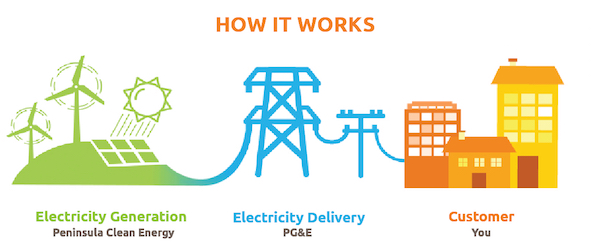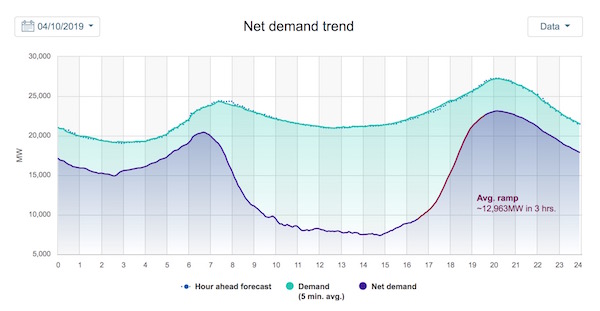You’ve heard the expression of building the plane while flying it? Now consider the case where:
- People keep bringing more and more luggage onto each flight, making the plane heavier and more crowded.
- The supplies you need to build the plane often don’t arrive when you need them.
- But you don’t have room to stockpile supplies, and delays are very costly.
- Random people on the flight are building parts of the plane, and you’re not entirely sure what they are doing.
- Your most critical partner, Plane Great Engineering, has filed for bankruptcy.
- And you are overwhelmed with documentation because ...
- You are being regulated by not one, not two, not three, but four different agencies, because no one wants the plane to crash (it has crashed before). And because ...
- The plane is the main way out of a burning city (which is why so many people are getting on it in the first place).
That is what it is like to operate a local electric utility these days in northern California. Fun times!
I had the opportunity to sit down with one of our fearless electric leaders to talk about how she makes it all work. Jan Pepper is CEO of Peninsula Clean Energy (PCE), which since April 2017 has been the default provider of electricity for all of San Mateo County.

Peninsula Clean Energy CEO Jan Pepper, in her office in Redwood City.
PCE is managing to provide cleaner and cheaper power across the county, fund the construction of the largest solar plant ever built for a community utility, and invest millions of dollars in local programs to reduce emissions, all while ensuring affordable and reliable service and navigating a thicket of ever-changing regulations. How is this possible?
Community choice electricity (CCA) was pioneered by Marin County in 2010, after California added support for local control following the rolling blackouts, price gouging, and PG&E Bankruptcy #1 of 2001. PG&E fought the Marin effort tooth and nail, spending over $4 million to stir up opposition, even threatening to cut off power until they were told by the state to stand down. There are now 19 community choice programs in California, with more on the way.

Map of current, planned, and potential CCAs from https://cal-cca.org/cca-impact
The CCAs in Northern California already cover about 30% of the electricity requirements within the PG&E service area. They are expanding in other parts of California as well, with the largest one nearing one million accounts in the Los Angeles area. Regulators estimate that less than 15% of the state’s retail load will be served by traditional investor-owned utilities by the mid-2020’s, with the rest handled by CCAs, municipal utilities, and direct electricity purchases by industry.
The way that community choice electricity works is the local provider (PCE in this case) handles purchasing of the power (e.g., the energy sources), while the incumbent (PG&E in this case) handles transmission, metering, and billing.

How are PG&E and the other investor-owned utilities responding to this? Jan observed that in theory they shouldn’t mind, since they are supposed to pass through the charges of the electricity providers, making a profit only on those resources that they own and operate. In fact they are slowly getting past their initial opposition and coming around to being “poles and wires” companies. San Diego Gas & Electric recently stated its intent to leave the power procurement business, due in part to difficulties signing long-term contracts when its customer base is rapidly eroding.
Poles and wires is a tricky business these days, given wildfire risks, hacker intrusions, and a need to rapidly build out the grid. Is PCE taking over the easy side of the problem? I asked Jan to talk about the tricky aspects of energy procurement.
The biggest risks that PCE manages are around the energy contracts. Longer-term contracts mean stabler supply and prices, and allow for meaningful investments in clean power. But they can result in higher prices as renewables get cheaper. Plus there are other considerations. Newer providers may be subject to defaulting. Many renewable sources provide only intermittent supply. And more remote sources can be hampered due to congestion on the grid. With so many factors to balance, PCE aims for a diversity of providers, locations, contract terms, technologies, and more.

Matching supply to demand is also a challenge, given intermittent sources like wind and solar and evolving demand requirements due to the proliferation of rooftop solar and electric vehicles. Across California, a surfeit of solar power is causing an excess of power at midday and a steep demand ramp-up in the evening, both of which are difficult to manage. It has gotten to the point where we sometimes pay other states to take our excess midday solar energy.
You can see this effect in the chart below from California’s largest grid operator, CAISO. The aqua line shows how demand on a recent Wednesday in April was depressed mid-day due to “behind the meter” (e.g., rooftop) solar panels reducing the load. This effect is exacerbated by the large proportion of solar in our grid, since it’s not available in the evening. If you subtract our solar (and wind) supply, as shown in the purple curve, you can see that the remaining sources need to handle a very steep ramp-up in demand in the evening, which is challenging.

You can find this chart and all kinds of interesting real-time supply, demand, and pricing data at CAISO’s “Today’s Outlook”.
Jan’s goal for PCE’s demand-supply balance is an ambitious one, namely to “match generation with load on a time-coincident basis”. When generation and load are balanced on an annual basis, as has been the standard, it masks the difficulties we face keeping our grid clean 24x7. To achieve an ongoing balance, Jan would love to see more solar systems paired up with storage, and to have more visibility and control over distributed resources like “behind the meter” solar systems and even EV batteries. With sufficient customer incentives, these distributed resources could be part of a larger and more stable power system. This diagram shows how charging and discharging of a storage system can smooth out the electricity supply. Storage can effectively remove excess midday supply (in orange) and augment the evening supply (in blue).

From PCE’s 2018 Integrated Resource Plan
So-called “time of use” metering, which incentivizes customers to use electricity when it is more available (and cheaper), can also help.
I asked Jan how it is that PCE manages to be both cleaner and more affordable than PG&E. A primary reason is that PCE is a not-for-profit government agency that is locally managed, with specific goals around providing clean and affordable energy. PG&E, on the other hand, is a privately run organization with its own agenda and a responsibility to investors. It also helps that Jan has over thirty years of experience in/around the utility business. PCE’s purposeful goals and policies reflect a deep commitment to local, sustainable, and equitable clean power.

PCE invests in local programs designed to lower County emissions. To increase adoption of electric vehicles, they have announced plans to invest $15 million over the next four years in charging infrastructure across the county. To get more segments of the community involved, they are also launching a brand-new program with Peninsula Family Services to help lower income households adopt electric vehicles. With a $4000 incentive and help purchasing a used plug-in hybrid, it is a great opportunity for qualifying families to reduce their emissions. These are just some examples of their local programs.
Jan is very excited about the future of PCE, and their ability to reduce emissions locally and to foster the development and greening of CCAs across California. PCE itself aims to be carbon-free by 2021, and fully renewable by 2025.
If you live or work in San Mateo County, here are some ways that you can help:
- For a simple and effective way to lower your emissions, join thousands of other families and workplaces by opting into PCE’s ECO100 plan, which is 100% renewable and carbon-free. For most households, it costs just a few dollars more per month than PCE’s default plan, which is 50% renewable and 85% carbon-free. Then tell your friends and neighbors about it!
- Think about ways to decrease your electric load in the 4pm-9pm timeframe when solar power wanes and demand grows steeply.
- If you have rooftop solar, or are thinking of installing it, consider pairing it with storage to help distribute the impact on the grid.
- If you are a fan of electric vehicles, you can help lower-income households adopt a used one by making a donation or by volunteering. Reach out to Peninsula Family Services, PCE’s partner for their “DriveForward” initiative.
- If you are committed to clean energy for San Mateo County, consider volunteering for PCE’s Citizens Advisory Committee, which meets about once a month and serves as a liaison for the community. You can find more information here.
Upcoming posts will continue this discussion about local electric power. How is Palo Alto managing its portfolio? What are we doing about power outages? And why are some California representatives proposing that we centralize procurement and shift it away from these local programs? Weigh in below with any questions or comments you have about PCE or your local electric service more generally. I believe that clean, reliable, affordable, and safe electricity is one of the most important things we need to achieve to hit California’s 2030 emissions goal, so this topic is important!
Notes and References
1. PCE has an easy to read and informative “integrated resource plan” from 2017, explaining its portfolio and outlook.
2. SFGate’s article from 2010 reflects some of the tension between Marin’s community energy initiative and PG&E. And a subsequent article reflects the state’s pushback on PG&E.
3. Cal CCA has a good overview of community choice electricity, as does Lean Energy.
4. Silicon Valley Clean Energy is another local community choice energy provider, serving Mountain View, Los Altos, and ten other cities in Santa Clara County.
Comment Guidelines
I hope that your contributions will be an important part of this blog. To keep the discussion productive, please adhere to these guidelines, or your comment may be moderated:
- Avoid disrespectful, disparaging, snide, angry, or ad hominem comments.
- Stay fact-based, and provide references (esp links) as helpful.
- Stay on topic.
- In general, maintain this as a welcoming space for all readers.



